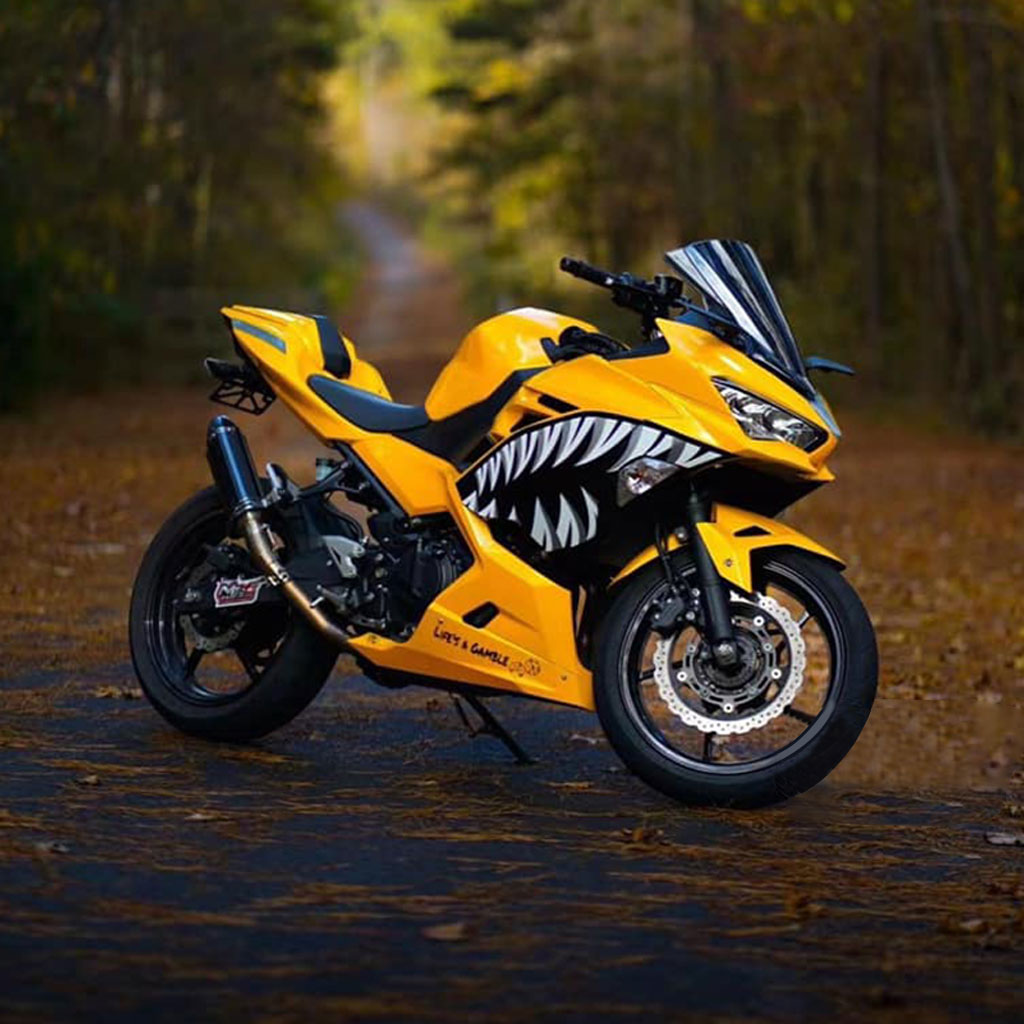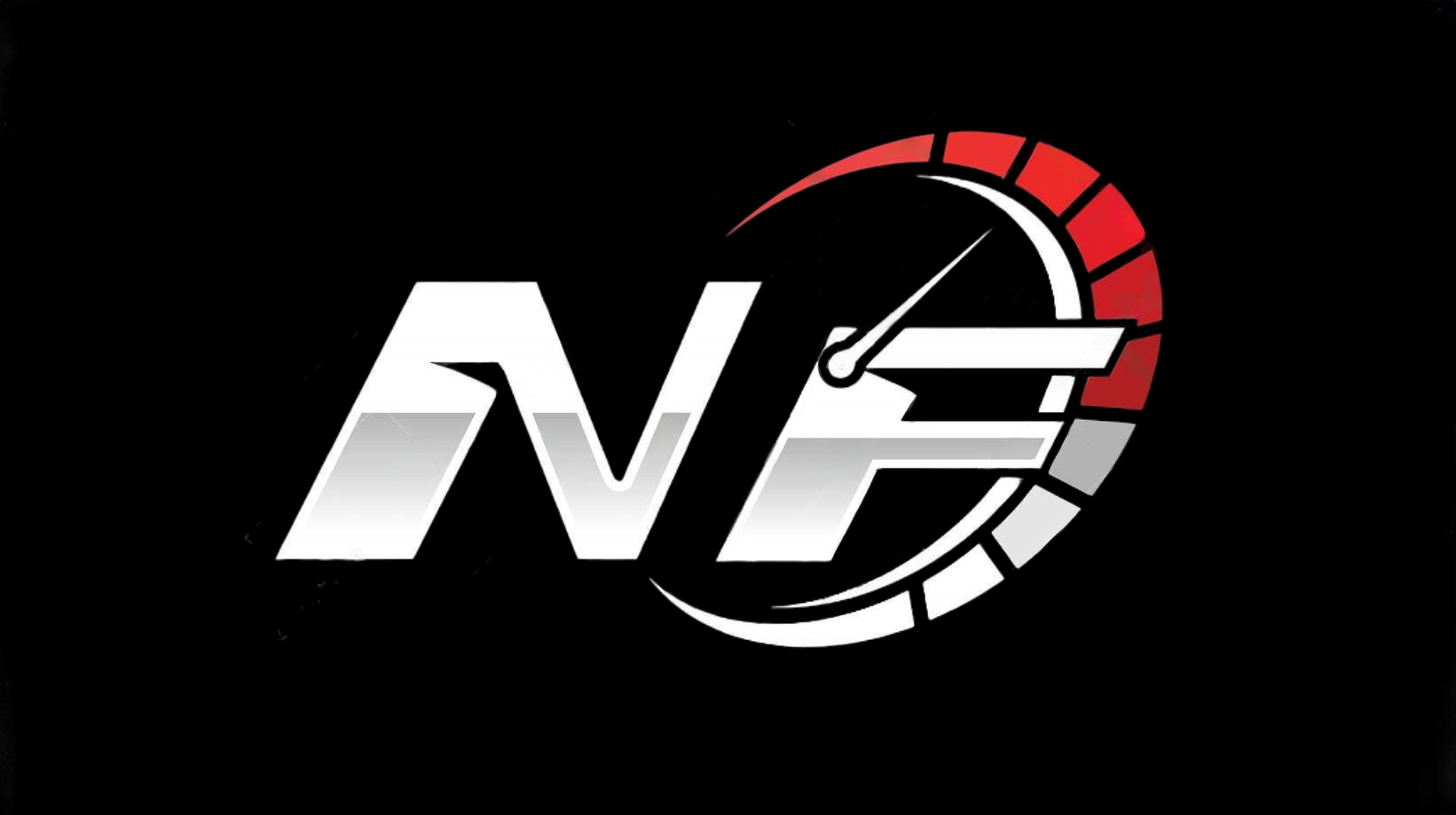Essential Tips for Enhancing Your Yamaha R6 Motorcycle in 2025
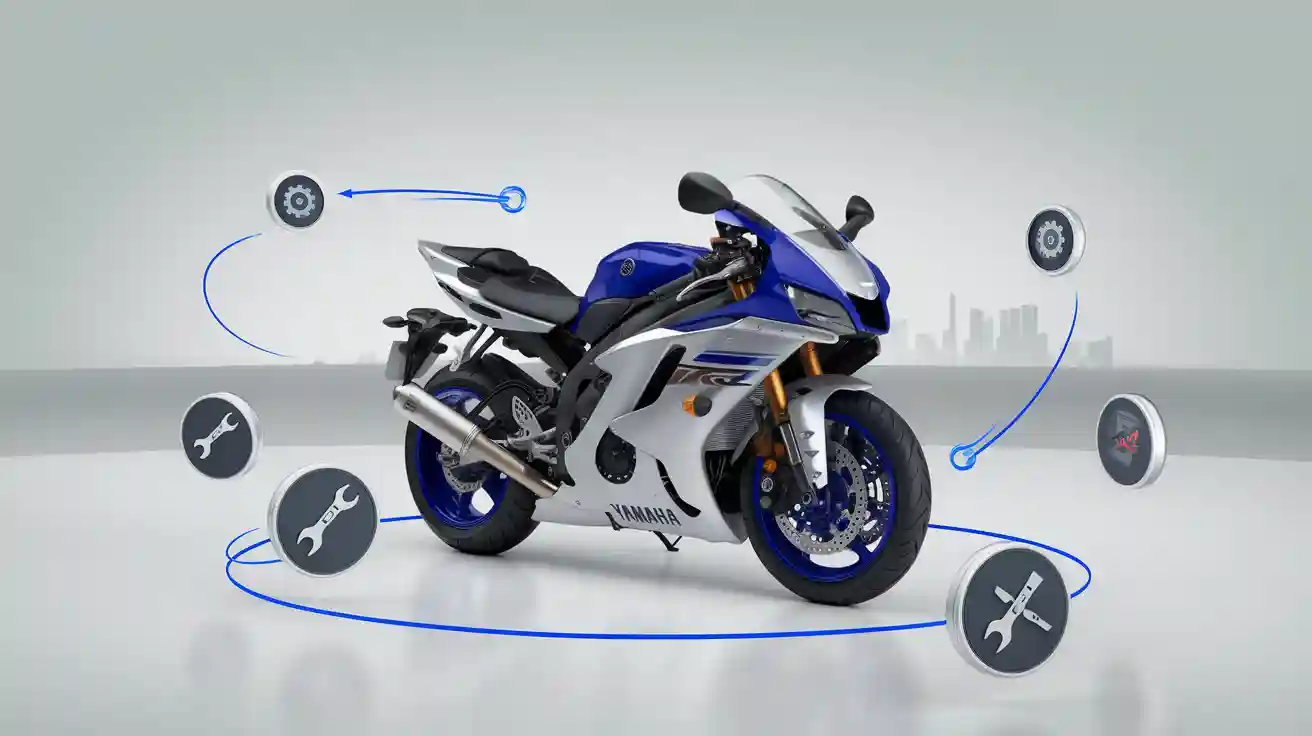
Yamaha continues to shape the world of supersport motorcycles with the iconic R6. Riders value the 2017 Yamaha YZF-R6 for its unmatched performance and racing heritage. This model stands out in Yamaha’s history as a sportsbike that delivers thrilling power and precise handling. Many riders seek upgrades to enhance the performance of their Yamaha R6 motorcycle. Experience on the track or street shows that the 2017 Yamaha YZF-R6 offers a unique riding experience. Yamaha engineers designed the R6 to excel in both everyday riding and high-speed racing. Riders respect the performance of the Yamaha R6 motorcycle and the legacy of the 2017 Yamaha YZF-R6 model.
Yamaha R6 Motorcycle Performance Upgrades
Engine Tuning and ECU Flashing for YZF-R6
Engine tuning stands as one of the most effective ways to unlock the full potential of the 2017 Yamaha YZF-R6. Riders often seek ECU flashing to remove factory restrictions and achieve sharper throttle response. Professional tuners report that a custom ECU flash can increase horsepower, improve acceleration, and optimize air-fuel ratios. The 2017 Yamaha YZF-R6 benefits from these upgrades, especially when paired with hardware changes like aftermarket exhausts and air filters. This combination helps the engine deliver maximum power and smoother delivery across the rpm range.
However, improper tuning or using generic maps can cause problems. Poor fuel economy, overheating, or even long-term engine damage may result. Riders should always work with reputable professionals who tailor the ECU flash to the specific model and modifications. Many choose plug-and-play tuning modules, such as Rapid Bike Tuning, for their ease of use and real-time adjustment. These modules allow riders to fine-tune air/fuel ratios and even adjust ignition timing or traction control. The EASY module offers a simple way to optimize the engine without computer tuning, making it accessible for both casual riders and those seeking a race-ready R6.
Tip: Always pair ECU tuning with supporting upgrades and professional guidance to ensure the best performance and reliability for your Yamaha YZF-R6.
Exhaust System Upgrades for Yamaha R6
Upgrading the exhaust system on the Yamaha R6 motorcycle can provide significant performance gains. Riders often replace the stock exhaust to reduce weight, increase power, and enhance the sound of the 2017 Yamaha YZF-R6. Aftermarket exhausts help the engine breathe better, which improves throttle response and acceleration. Many supersport enthusiasts choose full systems or slip-ons to achieve a more aggressive tone and a boost in speed.
- Aftermarket exhaust systems on motorcycles, including Yamaha R6, are technically illegal in California because they lack required EPA or CARB certification stamps.
- These exhausts are often labeled 'Track use only' to indicate non-compliance for street use.
- Law enforcement may use the presence of non-OEM exhausts as a reason to stop riders, but citations usually occur when riders are stopped for other reasons or due to disruptive behavior like loud noise.
- Legislative efforts exist to require visible OEM or certified stamps on exhausts to aid enforcement, but enforcement remains inconsistent.
- Riders with non-certified aftermarket exhausts face potential legal consequences such as fines or citations, especially in markets with strict emissions and noise regulations.
- The evidence primarily reflects California's legal environment, suggesting similar implications in other major markets with comparable laws.
Riders should always check local laws before installing non-OEM exhausts. Many systems are labeled for track use only, so using them on public roads can lead to fines or other penalties. For those who want to keep their Yamaha YZF-R6 street-legal, choosing an exhaust with proper certification is essential. Upgrading the exhaust, when done correctly, helps the engine reach higher performance levels and supports other track upgrades.
Suspension Improvements for R6 Handling
Suspension upgrades play a key role in improving the handling and comfort of the 2017 Yamaha YZF-R6. The stock suspension may not meet the needs of riders who push their supersport model on the track or demand more from their street rides. Professional reviews highlight the benefits of custom rear shocks, such as those built by Cogent Dynamics. These shocks are tailored to the rider’s weight and preferences, providing a more predictable and grippy setup.
- The most effective suspension upgrade for the Yamaha R6 is a custom rear shock built by Cogent Dynamics, tailored to the rider's weight (180 pounds) and preferences.
- The stock suspension was considered inadequate for track use, necessitating replacement.
- Professional suspension tuning by Rick Tannenbaum, a recognized suspension expert and owner of Cogent Dynamics, was crucial for achieving optimal handling.
- The custom suspension significantly improved confidence-inspiring handling and made the bike more fun and faster on the track.
- The upgrade also benefits street riding by providing a more predictable and grippy setup.
- The price was around $1,000, with the advantage of local servicing and durability for the life of the bike.
The Yamaha YZF-R6 features fully adjustable front and rear suspension. Riders can fine-tune preload, compression, and rebound damping to match their riding style. This adjustability enhances agility, responsiveness, and stability, especially in tight corners and during high-speed track sessions. The forward-lean riding position and ergonomic design also help reduce fatigue during longer rides. Riders report that these upgrades make the 2017 Yamaha YZF-R6 more fun, faster, and safer, whether on the street or the track.
Note: Investing in professional suspension tuning ensures the best balance between comfort and performance for your supersport model.
Brake Enhancements for Yamaha YZF-R6
Upgrading the brakes on the 2017 yamaha yzf-r6 gives riders a major boost in performance and safety. The r6 comes with a dual rotor, 4-piston caliper system that outperforms many other supersport motorcycles. Riders who want to push their yzf-r6 to higher speeds or track use often look for brake upgrades that reduce stopping distances and improve control. The yamaha yzf-r6’s advanced braking system handles the demands of high speed and aggressive riding.
The following table compares the braking performance of the yamaha yzf-r6 with a smaller model, showing how the r6’s system leads to shorter stopping distances and better power management:
| Parameter | Yamaha YZF-R3 (Stock) | Yamaha YZF-R6 (Stock) / Upgrade |
|---|---|---|
| Front Tire Size | 110/70 | 120/70 |
| Front Tire Contact Patch | Smaller (baseline) | ~5% larger contact patch |
| Front Brake Setup | Single rotor, 2-piston caliper | Dual rotors, 4-piston calipers |
| Rider Weight Assumed | 200 lb | 200 lb |
| Total Weight | 256 kg | 278 kg |
| Stopping Distance from 60 mph | 40 meters | 37.8 meters (13% shorter) |
| Braking Force at 60 mph | 2332.8 N | 2641.1 N |
| Stopping Distance from 112 mph | 138 meters | 131 meters (5% shorter) |
| Stopping Distance at 165 mph | N/A | 297 meters (requires larger brake surface) |

The r6’s larger front tire and advanced brake setup give it a 13% shorter stopping distance from 60 mph compared to smaller bikes. At higher speeds, the yzf-r6 still stops faster, with a 5% improvement at 112 mph. The system’s power and heat management allow the 2017 yamaha yzf-r6 to perform well even at its top speed. Riders should remember that tire grip limits braking performance, so upgrading tires along with brakes brings the best results.
Tip: Riders who want the best stopping power for their yamaha r6 should consider both brake and tire upgrades. This combination improves safety and performance for street and track use.
Electronics and Rider Aids for R6 Performance
The 2017 yamaha yzf-r6 stands out in the supersport class because of its advanced electronics and rider aids. These features help riders control the r6’s power and speed while boosting safety and confidence. The yzf-r6 includes a traction control system that prevents wheel spin during hard acceleration. Riders can adjust the intervention level to match their style or road conditions. This system uses sensors to monitor wheel speed and lean angle, then adjusts the engine’s throttle, fuel delivery, and ignition to keep the bike stable.
A quick shift system on the yamaha r6 allows clutchless upshifts. This feature lets riders change gears faster and smoother, which improves lap times and makes the r6 more fun to ride. The anti-lock braking system (ABS) prevents wheel lock-up during hard braking. This keeps the yzf-r6 stable and helps riders stop safely, even in emergencies. Many riders appreciate these aids for daily riding, but racers sometimes turn off ABS to use advanced braking techniques on the track.
The yamaha yzf-r6 also offers multiple engine modes. Riders can choose how much power the engine delivers, which helps them adapt to different weather or track conditions. The ride-by-wire throttle system gives precise control over the engine, making the r6 feel responsive and smooth. These customizable settings let riders get the most out of their 2017 yamaha yzf-r6, whether they want maximum performance or extra safety.
User feedback shows that the r6’s electronics boost rider confidence. The traction control system, with its six levels, keeps the bike stable on tricky surfaces. The quickshifter and traction control work together to give faster corner exits and better tire performance. Riders say these features make the yzf-r6 easier to handle at high speed and help them focus on improving their skills.
Note: The yamaha r6’s electronics and rider aids give both new and experienced riders more control, safety, and performance. Riders can adjust these systems to match their needs, making the 2017 yamaha yzf-r6 a top choice for anyone who wants a customizable supersport experience.
Customization Options for Yamaha R6 Motorcycle
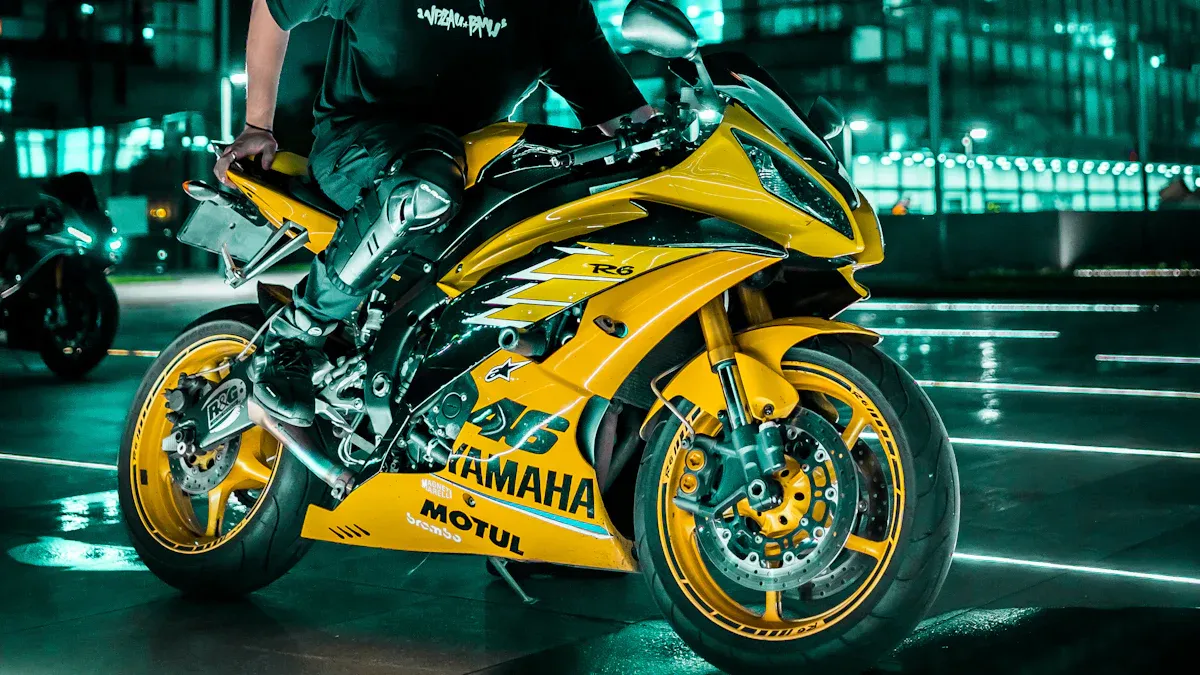
Bodywork and Fairings for YZF-R6
The 2017 yzf-r6 stands out with its advanced bodywork and fairing design. Yamaha engineers shaped the fairings using wind tunnel testing. This process reduced drag and improved airflow. The fairings use lightweight materials like plastics and carbon fiber. These materials lower the weight of the yzf-r6 and help with speed and handling. The design takes inspiration from the YZF-R1, giving the r6 a sleek look and better aerodynamics. Riders notice higher top speeds and more stable handling at high speeds. Many choose to add R&G Racing aero style frame sliders. These sliders protect the motorcycle during a fall. They use high-density polyethylene and have a tear-drop shape. This shape keeps the airflow smooth and protects the frame, fairing, and engine. Riders who upgrade the bodywork and fairings on their yzf-r6 see gains in both performance and safety.
Ergonomics and Controls Customization for R6
Riders often upgrade the ergonomics and controls on the yzf-r6 to improve comfort and control. Adjustable rearsets let riders change footpeg positions. This helps match the setup to their body size and riding style. Higher and more rearward footpegs give the r6 more ground clearance. Riders can lean deeper into corners without scraping. CNC-machined billet aluminum rearsets offer better feedback and last longer than stock parts. Many rearsets also support quick shifters and reverse shift patterns. Riders feel more connected to the yzf-r6 and can make faster, more precise movements. Adjustable levers also help. Riders can set the distance to match their hand size. These changes reduce fatigue and boost confidence, especially during long rides or track sessions. One rider reported shaving nearly two seconds off lap times after upgrading the controls on their yzf-r6.
Lighting Upgrades for Yamaha R6 Motorcycle
Lighting upgrades make the yzf-r6 safer and more visible. Many riders switch to LED bulbs like the GTR Lighting CSP Mini. These bulbs fit the tight headlight housing on the r6 and give better side-to-side lighting. Riders feel more confident riding at dusk or at night. One rider, Caleb, said he felt much safer with LED headlights. He noticed that other drivers saw him better compared to the stock yellow bulbs. Upgraded turn and brake signals, such as GTR Carbide 2.0 bulbs, make the rider’s intentions clearer. Morimoto Mod Pods allow for custom lighting setups, including daytime running lights. Some riders choose full LED headlight housings from brands like JW Speaker. These lights have adaptive beams that move with the motorcycle in corners. This feature helps riders see better when turning. HID Nation also offers LED and HID kits for the yzf-r6. These upgrades give instant bright light and last longer than stock bulbs. Riders who upgrade the lighting on their yzf-r6 improve both their own visibility and the safety of others on the road.
Tip: Upgrading the lighting on the yamaha r6 motorcycle not only improves style but also boosts safety for every ride.
Wheels and Tires for YZF-R6 Customization
Wheels and tires play a big role in how the yzf-r6 handles and looks. Riders often choose to upgrade these parts to improve grip, reduce weight, and give their yzf-r6 a unique style. Lighter wheels help the yzf-r6 accelerate faster and turn more easily. Many riders pick forged aluminum or carbon fiber wheels for their yzf-r6. These materials make the wheels strong but light. A lighter wheel means the yzf-r6 can change direction quickly, which helps on both the street and the track.
Tires also affect how the yzf-r6 feels on the road. Riders should pick tires that match their riding style. Some tires work best for daily riding, while others are made for racing. Sport tires give the yzf-r6 better grip in corners and help the rider feel more confident. Track-focused tires heat up fast and stick to the road, but they may wear out quickly if used every day. Riders should check the tire size and make sure it fits the yzf-r6. The right tire size keeps the bike stable and safe.
Tip: Riders should check tire pressure often. The correct pressure helps the yzf-r6 handle well and makes the tires last longer.
Some riders add colored rim tape or custom wheel finishes to make their yzf-r6 stand out. These changes do not affect performance, but they give the yzf-r6 a personal touch. Riders who want the best performance should balance looks with function. Upgrading wheels and tires gives the yzf-r6 better handling, more grip, and a fresh look.
| Upgrade Type | Benefit for YZF-R6 |
|---|---|
| Forged Wheels | Lower weight, faster turns |
| Sport Tires | More grip, better control |
| Custom Finishes | Unique style |
Maintenance and Reliability for Yamaha R6 Motorcycle
Routine Checks and Preventive Care for R6
Routine checks keep the yzf-r6 running smoothly and help riders avoid unexpected problems. Yamaha recommends following a strict maintenance schedule for the yamaha r6 motorcycle. Regular oil changes every 4,000 miles keep the engine lubricated and prevent wear. Chain maintenance every 500 miles, especially after wet riding, ensures the drivetrain stays reliable. Valve clearance checks at 26,600 miles help the yzf-r6 maintain peak performance. Riders should also inspect lights, signals, and tire pressure every year. These steps protect both the bike and the rider experience.
| Maintenance Interval | Tasks / Checks | Impact on Reliability |
|---|---|---|
| Every 4000 miles | Change engine oil, inspect components, replace spark plugs every second service | Keeps engine lubricated and running smoothly, prevents premature wear |
| Every 26600 miles | Valve clearance check and adjustment | Ensures optimal engine performance and prevents valve damage |
| Every 500 miles | Chain maintenance and lubrication, especially after wet conditions | Maintains drivetrain reliability and prevents chain wear or failure |
| Annually | Lubricate brake/clutch levers, check lights, signals, tire pressure | Ensures safety-critical components function properly and prevents failures |
| Every 2 years | Change brake fluid | Maintains braking performance and prevents brake system corrosion |
| Every 3 years | Change coolant | Prevents overheating and cooling system damage |
| Every 4 years | Replace brake hoses | Prevents brake fluid leaks and failure |
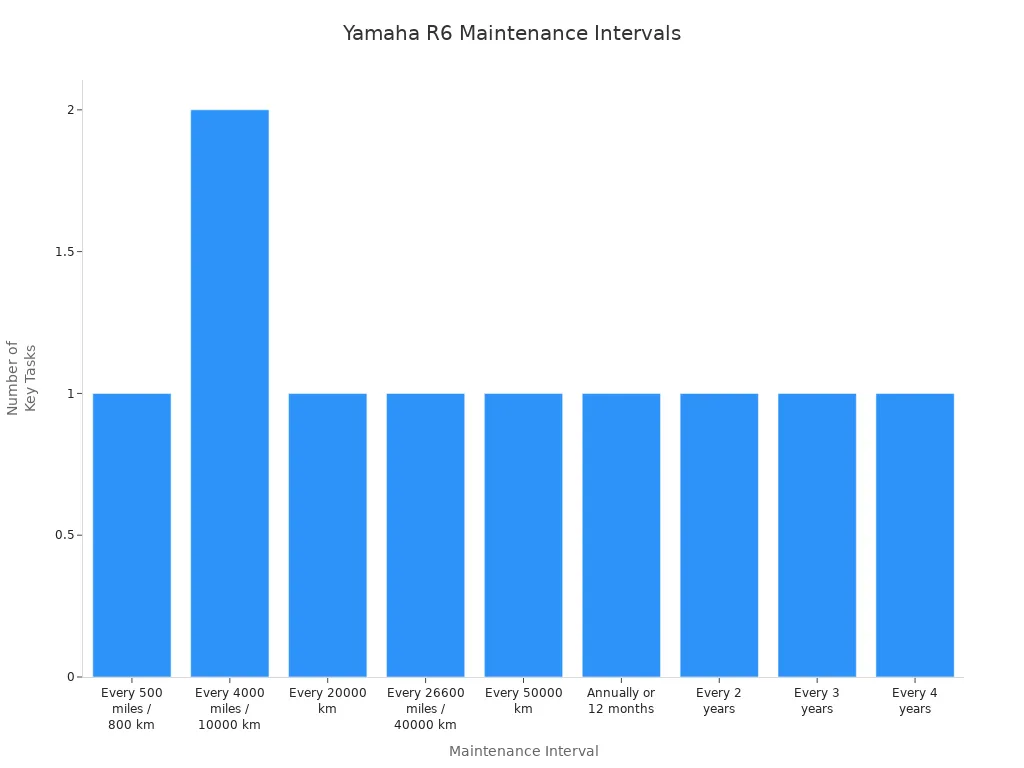
Tip: Following these intervals helps the yzf-r6 deliver a reliable and safe riding experience.
Parts Longevity and Replacement on Yamaha YZF-R6
Parts on the yzf-r6 have different lifespans based on how riders use their bikes. Brakes last between 25,000 and 65,000 miles, while tires need replacement every 5,000 to 8,000 miles. Spark plugs should be changed every 8,000 miles to keep the engine firing properly. Transmission parts can last up to 120,000 miles with proper care. Regular oil changes and air filter cleaning extend engine life and improve the rider experience.
| Part | Average Lifespan (miles) |
|---|---|
| Brakes | 25,000 - 65,000 |
| Tires | 5,000 - 8,000 |
| Transmission | 100,000 - 120,000 |
| Spark Plugs | 8,000 |
| Engine Oil | Replace every 4,000 miles |
| Air Filter | Regular cleaning/replacement recommended |
Note: Riders who track their yzf-r6 closely can plan replacements and avoid breakdowns, making every riding experience safer.
Integrating Modern Tech for R6 Reliability
Modern technology improves the reliability of the yzf-r6 and makes maintenance easier. Features like traction control and ABS help prevent accidents and reduce stress on mechanical parts. Ride modes let riders adjust the bike for different conditions, which leads to smoother operation and less wear. The quick shifter allows clutchless upshifts, protecting the clutch and transmission. The LCD display gives real-time information, helping riders spot issues early and plan maintenance. These features enhance the rider experience and keep the yzf-r6 performing at its best.
| Feature | Contribution to Reliability and Maintenance Efficiency |
|---|---|
| Traction Control | Prevents wheel spin during acceleration, enhancing stability and reducing mechanical stress. |
| Ride Modes | Allows adjustment for different riding conditions, promoting smoother operation and less wear. |
| Quick Shifter | Enables clutchless upshifts, reducing mechanical wear on the clutch and transmission. |
| ABS | Prevents wheel lock-up during braking, improving safety and reducing brake system strain. |
| LCD Display | Provides essential riding information, helping riders monitor bike status and identify maintenance needs early. |
Riders who use these technologies report a better overall rider experience and fewer unexpected repairs on their yzf-r6.
Legal and Environmental Considerations for Yamaha R6 Motorcycle
Emissions Compliance for YZF-R6
Emissions rules for motorcycles have become stricter in recent years. Yamaha R6 owners must understand how these rules differ around the world. The European Union uses Euro 5 standards, which set very low limits for carbon monoxide and hydrocarbons. The United States follows EPA rules, while California uses CARB standards. These American rules allow higher emissions than Euro 5, but still require regular checks and warranties. Japan’s standards often follow the European model.
| Region/Standard | Carbon Monoxide (g/km) | Hydrocarbons (g/km) | Hydrocarbons + NOx (g/km) | Durability / Warranty |
|---|---|---|---|---|
| European Union (Euro 5) | 1.0 | 0.1 | N/A | Lifetime durability, advanced OBD required |
| United States (EPA) | 12.0 | 1.0 (small engines) | 0.8 (large engines) | 5 years / 18,000-30,000 km |
| California (CARB) | 12.0 | 1.0 (small engines) | 0.8-1.4 | Not specified |
Euro 5 also requires advanced onboard diagnostics. Many manufacturers design motorcycles to meet Euro 5 so they can sell them worldwide. Yamaha R6 owners should check which standard applies in their area before making changes to the exhaust or engine.
Noise Regulations and R6 Modifications
Noise laws affect how riders can modify their Yamaha R6. Many states and countries limit how loud a motorcycle can be. California, for example, does not allow aftermarket exhausts that change or remove the original emissions equipment unless the part has special approval. Parts labeled “Race Only” are not legal for street use. Using non-certified exhausts on public roads can break federal laws.
- CARB forbids aftermarket parts that change emissions devices unless approved.
- “Race Only” parts are for closed tracks, not public roads.
- Many popular exhausts for the R6 do not meet noise or emissions rules.
- Riders must check local laws and manufacturer details before installing new parts.
Penalties for breaking noise laws vary by state. For example:
| Region | Penalty Type | Description |
|---|---|---|
| Rhode Island | Civil violation | Riders must fix illegal exhausts within 5 days or face fines. |
| Ohio | Minor misdemeanor | Fines go to local funds for muffler and noise law violations. |
| Montana | Noise limit enforcement | Riding over 95 decibels is not allowed; proof is needed for conviction. |
Street-Legal Modifications for Yamaha R6
To keep a Yamaha R6 street-legal in 2025, riders must follow safety and emissions rules. The R6 Race model, made for tracks, needs several changes before it can go on public roads. These include:
- Headlights, brake lights, and taillights
- Mirrors and a horn
- Turn signals
- DOT-approved tires
- A legal exhaust system with a catalytic converter
- Reflectors and a license plate bracket
Some R6 Race models do not have the right VIN, so a special inspection is needed. Emissions certification is also required. Rules differ by state. California has strict standards and may not allow some conversions. States like Florida and Texas are more flexible if the bike passes safety checks. Insurance companies may refuse coverage for heavily modified bikes. Riders often find it easier to buy a street-legal R6 or use the Race model only on tracks.
Tip: Riders should always check local DMV and insurance rules before making major changes to their Yamaha R6. This helps avoid fines and keeps the motorcycle safe and legal.
Yamaha R6 riders see the most satisfaction when they focus on performance upgrades like suspension tuning, ECU flashes, and brake improvements. Many plan for performance exhausts, quick shifters, and advanced electronics to boost both safety and performance. Safety features such as ABS and traction control increase rider confidence and long-term satisfaction. Legal compliance remains important, especially as stricter rules affect motorcycle usability. Riders should choose performance enhancements that match their goals. Experts and owners agree that targeted performance upgrades transform the R6 into a top motorcycle for both street and track. Start preparing now to enjoy the best performance next season.
FAQ
What are the best first upgrades for a Yamaha R6 in 2025?
Riders often start with suspension tuning, upgraded brake pads, and LED lighting. These changes improve safety, comfort, and visibility. Many experts recommend these upgrades before making engine or exhaust modifications.
Can riders use aftermarket exhausts on public roads?
Most aftermarket exhausts lack certification for street use. Riders should check local laws. Many areas require EPA or CARB approval. Using non-certified exhausts can lead to fines or failed inspections.
How often should riders service the Yamaha R6?
Yamaha recommends oil changes every 4,000 miles and chain maintenance every 500 miles. Valve checks should occur at 26,600 miles. Regular service keeps the R6 reliable and safe.
Is it possible to make an R6 Race model street-legal?
Some R6 Race models can become street-legal with added lights, mirrors, and a certified exhaust. Riders must pass inspections and meet local rules. Not all states allow these conversions.
Do electronic rider aids help new riders?
Electronic aids like ABS and traction control help riders stay safe. These systems prevent wheel spin and lock-up. Many new riders feel more confident with these features on the Yamaha R6.
See Also
Key Advice To Construct Your Ideal Motorcycle Project
Reasons The 2025 Yamaha R7 Is Truly Unique
Top Reasons To Own Yamaha R6 Fairings Today
